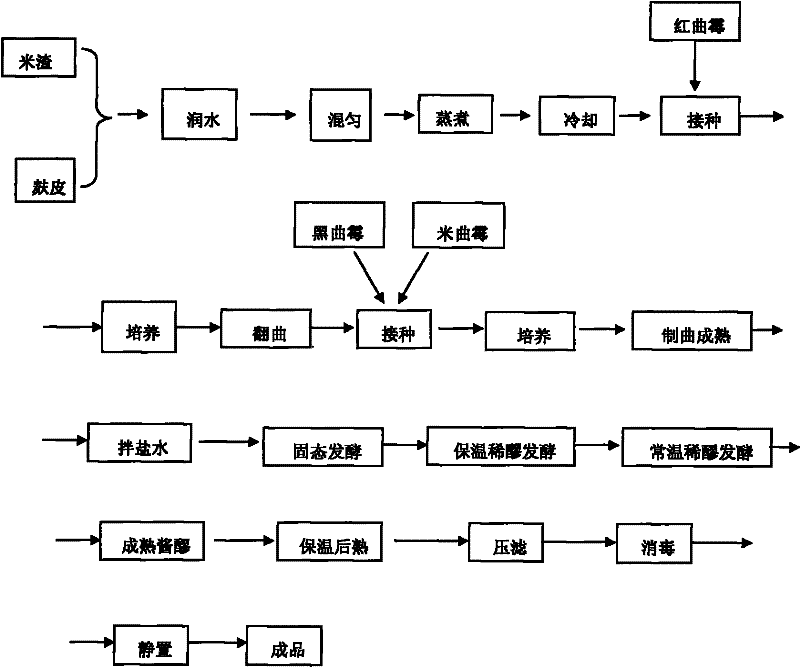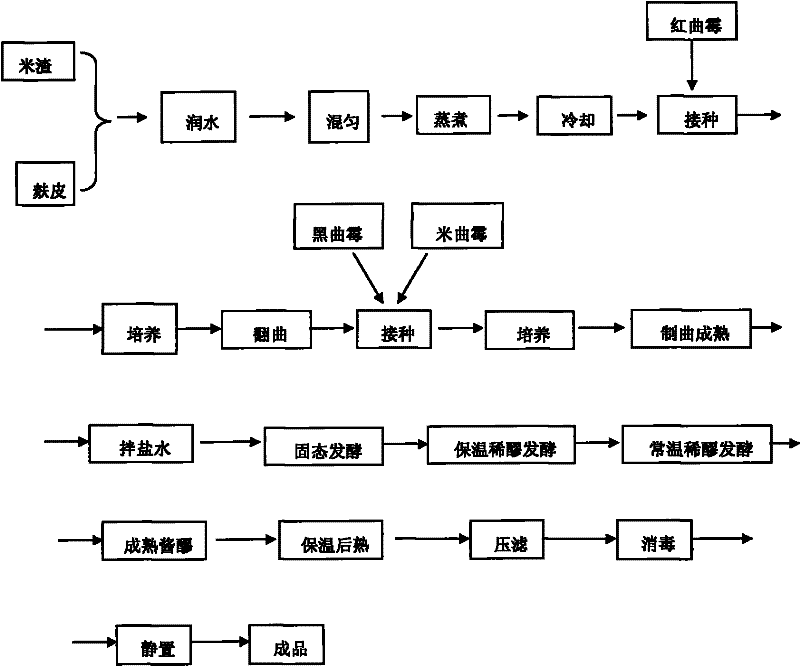Multi-strain starter propagation process for producing soy sauce by using rice dregs as raw materials
A production process and technology of rice dregs, applied in the field of waste resource recycling, can solve the problems of unacceptable to consumers, high amino acid nitrogen, difficult to obtain, etc., and achieve the effect of improving application value and reducing production cost.
- Summary
- Abstract
- Description
- Claims
- Application Information
AI Technical Summary
Problems solved by technology
Method used
Image
Examples
Embodiment approach 1
[0019] Get 200 kilograms of rice dregs and 120 kilograms of bran, add water at 80 ° C, and control the moisture content to be about 35%. Stir evenly, steam the material with a rotary steamer under pressure (0.3MPa) for 1.5 hours. Cool the clinker rapidly to 37°C, add 5% Monascus liquid seeds according to the weight of the raw materials, mix evenly, move it into the koji pool to make koji, the thickness of the koji layer is 25cm, keep the koji material loose and the thickness is consistent, and the product temperature should be controlled during the koji making process 30°C, the relative humidity of the koji room is above 90%, and the koji is turned over every 8 hours after 24 hours of koji making, and then added to the mixed liquid strains of 5% Aspergillus oryzae and 5% Aspergillus niger on the fourth day of cultivation. Continue ventilating and culturing at 28-32°C for 2 days, the highest temperature shall not exceed 35°C, and turn the koji 2-3 times. Under this condition, t...
Embodiment approach 2
[0021] Get 100 kilograms of rice dregs and 60 kilograms of bran, add water at 80 ° C, and control the moisture content to be about 35%. Stir evenly, steam the material with a rotary steamer under pressure (0.3MPa) for 2 hours. Cool the clinker rapidly to 40°C, add 5% red yeast rice powder according to the weight of the raw material, mix evenly, move it into the koji pool to make koji, the thickness of the koji layer is 30cm, keep the koji material loose and the thickness is consistent, and the temperature of the product should be controlled during the koji making process 32°C, the relative humidity of the koji room is above 90%, and the koji is turned over every 8 hours after 24 hours of koji making, and 0.1% of Aspergillus oryzae spores and 0.3% of Aspergillus niger spores are reintroduced on the fourth day of cultivation. Continue to ventilate and cultivate for 2 days at 28-32°C, the highest temperature does not exceed 35°C, and turn over 3 times. Evenly mix in 13° Be' salt...
PUM
 Login to View More
Login to View More Abstract
Description
Claims
Application Information
 Login to View More
Login to View More - R&D
- Intellectual Property
- Life Sciences
- Materials
- Tech Scout
- Unparalleled Data Quality
- Higher Quality Content
- 60% Fewer Hallucinations
Browse by: Latest US Patents, China's latest patents, Technical Efficacy Thesaurus, Application Domain, Technology Topic, Popular Technical Reports.
© 2025 PatSnap. All rights reserved.Legal|Privacy policy|Modern Slavery Act Transparency Statement|Sitemap|About US| Contact US: help@patsnap.com


